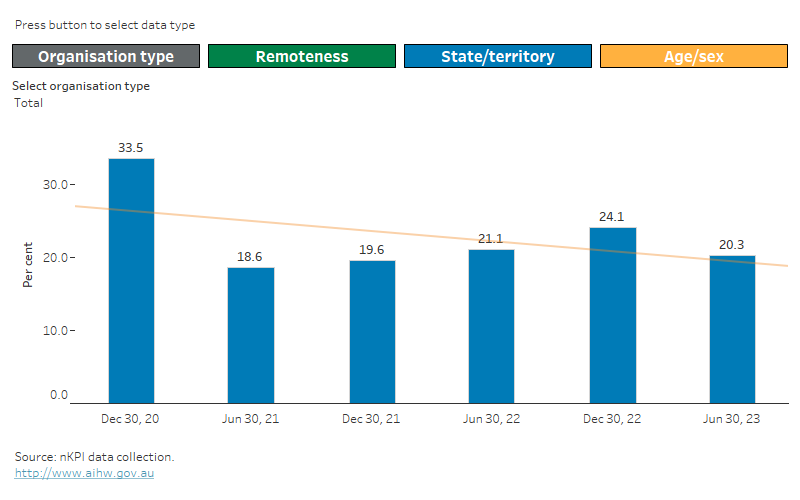Immunised against influenza (PI14)
This indicator is the proportion of First Nations regular clients aged 6 months and over who received an influenza immunisation within the previous 12 months.
It is collected for males and females in age groups:
- 6 months–4 years
- 5–14 years
- 15–24 years
- 25–34 years
- 35–44 years
- 45–54 years
- 55–64 years
- 65 years and over.
There have been changes to the specification of this indicator over time. For more information see Interpreting nKPI data.
Why immunisation against influenza is important
Influenza (the flu) is a contagious respiratory disease that causes seasonal epidemics in Australia. Anyone can be infected with influenza but some people, such as First Nations people, have a higher chance of serious illness and complications, such as pneumonia. Some people with influenza die as a result of their infection. Annual influenza vaccination substantially reduces the risk of hospitalisation and death from influenza and pneumonia for First Nations people (AIHW 2023).
At June 2023, 20% (or around 76,000) of First Nations regular clients aged 6 months and over received an influenza immunisation within the previous 12 months (Figure 1).
Figure 1: Immunised against influenza by reporting period
Immunised against influenza by reporting period
This Tableau visualisation shows the percentage of First Nations regular clients aged 6 months and over who had an influenza immunisation in the last year, for reporting periods from December 2020 to June 2023 for either:
- type of organisation (ACCHO, non-ACCHO)
- remoteness area (Major cities, Inner regional, Outer regional, Remote, Very remote)
- state/territory (NSW/ACT, Vic, Qld, WA, SA, Tas, NT)
- age/sex (male, female with age group 6 months–4 years, 5–14, 15–24, 25–34, 35–44, 45–54, 55–64, 65 and over).
Data supporting this visualisation are available in Excel supplementary data tables at Data.

Notes
- In December 2020, specifications changed for this indicator and data from that point on cannot be compared with previous periods. For more information see Interpreting nKPI data.
- For more information, including on interpreting changes over time, see Technical notes.
For more information on influenza immunisation see Data.
Reference
AIHW (Australian Institute of Health and Welfare) (2023) Aboriginal and Torres Strait Islander Health Performance Framework: immunisation, AIHW, Australian Government, accessed 1 November 2023.


